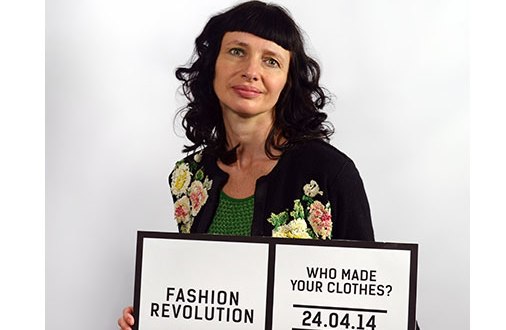
CARRY SOMERS: «Fashion can be a force for good»
She revolutionized the world of fashion with a simple and complex question: «Who made your clothes?». That raised awareness about working conditions in the textile industry and founded the international movement Fashion Revolution. A conversation between women about fashion, but conscious fashion.
A woman talking about clothes, typical cliché of modern society. A woman asking to the giant of fashion «Who made my clothes?», one of the great landmarks of the century. It is that the collapse of the conglomerate garment factories Rana Plaza in Bangladesh, which occurred on April 24, 2013, marked a before and after in the life of the British designer Carry Somers and, consequently, in the life of millions of consumers around the world: the accident exposed the precarious working conditions behind clothes at low cost that were sold in large stores in major North American, European and Latin American cities. And Carry decided not to remain silent. On the contrary, she began to bother the industry from a proactive, positive outlook with the firm proposal to start changing.
Already in 1992, she founded the first certified fair trade company: Pachacuti, a company that empowers excluded women by making hats made from environmentally friendly materials and offered on the market at a fair price. What came next was to continue the search for fashion in a different way, with a more ethical view, with a more conscious style, with a more sustainable way … In short, revolutionize fashion.
Why did you decide to start with this great movement called Fashion Revolution?
I don´t think it was me who decided to start it. It was not an idea I had in mind. Rather, the idea found me. And it was from this that I decided to start doing something. After the accident of Rana Plaza in Bangladesh, we were all in shock, but at the same time we knew that something like this could happen, that still was not seeing the whole picture of what was happening in the world of fashion, in terms of transparency. The first thing I thought was that this could be an opportunity to show the world the necessity and the importance of transparency in the supply chain in the fashion industry. Days after the tragedy of Rana Plaza, people looked at the labels of their clothes, just to know if they had been created by some of these big brands of clothes. That was how the movement emerged and that’s how I decided to drive the Fashion Revolution Day like a good idea to start doing something with the problem. I contacted organizers of Fashion Week in London and representatives of the fashion world who were convinced that it was necessary to discuss these issues, and they wanted a more ethical and transparent future for fashion.
How do you see the industry today? Do you think there were some changes in favor, or still we have challenges to face?
We still have many challenges. The fashion industry is really huge and no one has a clear and comprehensive picture of how it works from the first link in the chain to the last. We need transparency in the industry. There have been some changes. The first year we promote the movement with the campaign «Who made my clothes?». The industry was surprised. People wanted to know, understand, know what the label said. Companies do not became aware of how many people watched and hoped to receive an answer. It was a kind of information that no one expected that it was requested. At least we needed to know where the final garments were made. With this transparency, it could prevent accidents like Rana Plaza continue happening.
Do you think that today people want to be more conscious about what they consume?
I think there are several aspects of the same theme. We need to know who owns our clothes: where we buy (in a store or at a fair), why we bought it (because it’s cheaper?). We need to keep our clothes longer, love them and know what to do with them when you stop using them. I always suggest that everything you buy, and know where it came from, share it on social networks with the hashtag #WhoMadeMyClothes, because that’s the best you can do to make the system starts changing industry. Is key to support independent designers with a more ethical proposal. We need to get the big brands of clothing and luxury accessories more sustainable, more ethical, and make that big shift towards transparency.
What has been the response of these large companies, considering that you were pointing the finger to tell them they were doing the wrong thing?
I believe that the big companies have nothing to worry about; they must know where their clothes come from. That is the purpose of our question. We do not make a negative campaign, we believe in the world of fashion, we are fashionistas and celebrate fashion, because we believe that fashion can be a force for good. We do not try to be a negative campaign, but work from a positive outlook. We want to give examples of those who work well; we want to be held to advise using something whose production chain is known. We want to show all those people who work behind every garment, rather than hide it. Big brands should not be ashamed, they need to hold from providing information on their processes. It is a simple question: «Who made my clothes?». Do not talk about your policies as a company, your policies do not tell me anything. I want to know what actually occurs inside the factories.
What is the impact of the fashion industry on the environment?
The fashion industry has a huge impact on the environment, in fact it is the second most polluting industry in the world. The number of liters used to make just a shirt! Or, in the case of cotton, the negative impact of their crops on health and on Earth. And due to the lack of transparency. Or the amount of waste that fashion generate, I could be talking about it a long time… We have to find the way our clothes last, recycling clothes. We can not continue this way discarding clothes.
Where do you believe is the main constraint to businesses in reducing their impact? They do not want to do it or do not know how?
I think most of the problem is that designers have been trained unsustainably. Apparel designers must be trained not only to design for factories, but also to redesign a second time and so on. That is, much remains to be done in the context of education industry.
What is the meaning of Fashion Revolution Day around the world?
It is about having a great impact one day a year. We want to unite our voices in a single message. We need to speak for the most vulnerable people of the working processes of industry. Fashion Revolution is a movement, it haven’t to be one day a year, but have to live every day, every moment that we dress.
How Fashion Revolution has impacted your life?
I know the history of each of my clothes, every day I leave my house. Knowing the story of what you wear, makes it more special for you. I can imagine the life it had before, and that makes it special for me. If I had to give a message to women, I will say them that it’s really important to remember that we can redefine the fashion industry every time we buy, every time we are curious, whenever we search for new stories behind our clothes, every time we asked a brand «who made my clothes?» and share information with others. It is then that we are truly redefining the world of fashion. We have a great power as consumers: we can all be revolutionary fashion and change the fashion industry.
Confession of author
The meeting with Carry Somers was the result of that magic that fate has prepared for us. She had been invited to participate as a speaker at the 2nd edition of the Social Innovation and Global Ethics Forum (SIGEF) in Geneva, Switzerland, and for that journalistic awakening, I saw the list of other speakers weeks before to take the plane. Carry was there and I decided to write an email to know her. Already in the beautiful European land, I will never forget her first concern: we had been asked not to use stamped or different colored dress on stage, by the effect of the lights. For her, it was not able to show the clothing designers largely responsible. But what struck me even more was that when I asked defiantly, if she could tell me the origin of what she was wearing that day, her answer was as strong as retailer. She knew not to describe the label of the company, not the designer’s name, but the story behind each garment accessory and looked minimum. And that’s something I’ll remember every time I look in the mirror, to ask the question: «Who made my clothes?».
